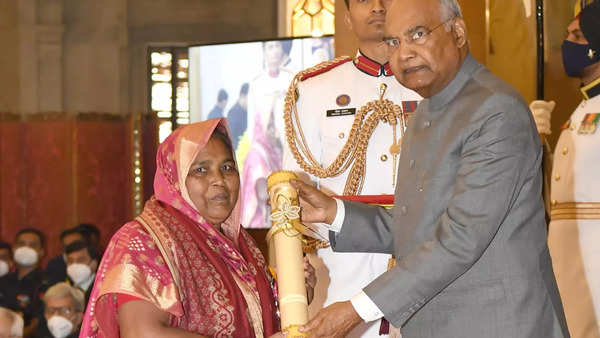On the occasion of her historic eighth consecutive Union Budget presentation, Union Finance Minister Nirmala Sitharaman arrived at Parliament donning a stunning saree that paid homage to India’s rich cultural heritage. The off-white handloom silk saree, adorned with intricate Madhubani artwork, was a special gift from renowned artist and Padma Shri awardee Dulari Devi. The saree not only symbolized the timeless beauty of Madhubani art but also spotlighted the artistry and craftsmanship of Bihar’s Mithila region.
Who is Dulari Devi?
Dulari Devi, a prominent name in the world of Madhubani art, was honored with the Padma Shri in 2021 for her contributions to preserving and promoting this traditional folk art. Her journey in Madhubani painting began under the mentorship of Karpoori Devi, an established artist in the Mithila region. Despite facing many personal challenges, including the loss of her husband and the hardships of rural life, Devi turned to art as both a livelihood and a form of expression. Today, her works are celebrated internationally, with over 10,000 paintings displayed in exhibitions around the world.

Dulari Devi met Nirmala Sitharaman during a credit outreach program at the Mithila Art Institute in Madhubani, where they discussed the importance of preserving Madhubani art and supporting its artisans. As a token of appreciation, Devi gifted the hand-painted saree to Sitharaman, urging her to wear it for the Budget Day. Sitharaman, known for using her attire to reflect India’s diverse cultural fabric, embraced the gift, choosing it to make a strong statement on the national stage.
All about Madhubani art
Madhubani art, also known as Mithila painting, has its roots in the Mithila region of Bihar. This traditional art form is distinguished by vibrant colors, intricate patterns, and detailed depictions of natural and mythological themes. Traditionally painted on walls, handmade paper, and cloth, the art is known for its use of natural dyes and pigments. Common motifs include peacocks, fish, lotus flowers, and geometric shapes, each symbolizing prosperity, fertility, and divine blessings. The paintings are crafted with meticulous detail, often filling the canvas with an elaborate network of patterns that leave no empty space.

The style is unique for its use of fine brushes, twigs, and even fingers to create precise, intricate designs. The art form, typically passed down through generations of women, has become a symbol of the Mithila region’s cultural identity and resilience. Through her gift, Dulari Devi not only honored Nirmala Sitharaman but also brought global recognition to the art form and the talented artisans of Bihar.
By wearing Dulari Devi’s Madhubani saree for such an important occasion, Nirmala Sitharaman has once again highlighted India’s rich textile and artistic traditions. From the vibrant patterns to the cultural significance, the saree serves as a tribute to India’s heritage and the artisans who continue to preserve and innovate its timeless art forms.






